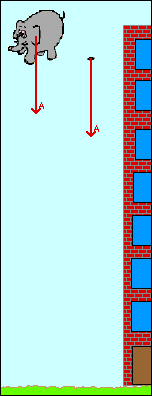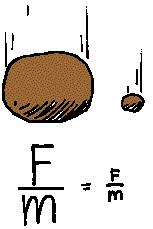Elephant and Feather - Free Fall
 Suppose that an elephant and a feather are dropped off a very tall building from the same height at the same time. Suppose also that air resistance could somehow be eliminated such that neither the elephant nor the feather would experience any air drag during the course of their fall. Which object - the elephant or the feather - will hit the ground first? The animation at the right accurately depicts this situation. The motion of the elephant and the feather in the absence of air resistance is shown. Further, the acceleration of each object is represented by a vector arrow.
Suppose that an elephant and a feather are dropped off a very tall building from the same height at the same time. Suppose also that air resistance could somehow be eliminated such that neither the elephant nor the feather would experience any air drag during the course of their fall. Which object - the elephant or the feather - will hit the ground first? The animation at the right accurately depicts this situation. The motion of the elephant and the feather in the absence of air resistance is shown. Further, the acceleration of each object is represented by a vector arrow.
Many people are surprised by the fact that in the absence of air resistance, the elephant and the feather strike the ground at the same time. Why is this so? This question is the source of much confusion (as well as a variety of misconceptions). Test your understanding by making an effort to identify the following statements as being either true or false.
TRUE or FALSE:
-
The elephant and the feather each have the same force of gravity.
-
The elephant has more mass, yet both elephant and feather experience the same force of gravity.
-
The elephant experiences a greater force of gravity, yet both the elephant and the feather have the same mass.
-
On earth, all objects (whether an elephant or a feather) have the same force of gravity.
-
The elephant weighs more than the feather, yet they each have the same mass.
-
The elephant clearly has more mass than the feather, yet they each weigh the same.
-
The elephant clearly has more mass than the feather, yet the amount of gravity (force) is the same for each.
-
The elephant has the greatest acceleration, yet the amount of gravity is the same for each.
If you answered TRUE to any of the above, then perhaps you have some level of confusion concerning either the concepts or the words force, weight, gravity, mass, and acceleration. In the absence of air resistance, both the elephant and the feather are in a state of free-fall. That is to say, the only force acting upon the two objects is the force of gravity. This force of gravity is what causes both the elephant and the feather to accelerate downwards. The force of gravity experienced by an object is dependent upon the mass of that object. Mass refers to the amount of matter in an object. Clearly, the elephant has more mass than the feather. Due to its greater mass, the elephant also experiences a greater force of gravity. That is, the Earth is pulling downwards upon the elephant with more force than it pulls downward upon the feather. Since weight is a measure of gravity's pull upon an object, it would also be appropriate to say that the elephant weighs more than the feather. For these reasons, all of the eight statements are false; there is an erroneous part to each statement due to the confusion of weight, mass, and force of gravity.
 But if the elephant weighs more and experiences a greater downwards pull of gravity compared to the feather, why then does it hit the ground at the same time as the feather? Great question!! To answer this question, we must recall Newton's second law - the law of acceleration. Newton's second law states that the acceleration of an object is directly related to the net force and inversely related to its mass. When figuring the acceleration of object, there are two factors to consider - force and mass. Applied to the elephant-feather scenario, we can say that the elephant experiences a much greater force (which tends to produce large accelerations. Yet, the mass of an object resists acceleration. Thus, the greater mass of the elephant (which tends to produce small accelerations) offsets the influence of the greater force. It is the force/mass ratio which determines the acceleration. Even though a baby elephant may experience 100 000 times the force of a feather, it has 100 000 times the mass. The force/mass ratio is the same for each. The greater mass of the elephant requires the greater force just to maintain the same acceleration as the feather.
But if the elephant weighs more and experiences a greater downwards pull of gravity compared to the feather, why then does it hit the ground at the same time as the feather? Great question!! To answer this question, we must recall Newton's second law - the law of acceleration. Newton's second law states that the acceleration of an object is directly related to the net force and inversely related to its mass. When figuring the acceleration of object, there are two factors to consider - force and mass. Applied to the elephant-feather scenario, we can say that the elephant experiences a much greater force (which tends to produce large accelerations. Yet, the mass of an object resists acceleration. Thus, the greater mass of the elephant (which tends to produce small accelerations) offsets the influence of the greater force. It is the force/mass ratio which determines the acceleration. Even though a baby elephant may experience 100 000 times the force of a feather, it has 100 000 times the mass. The force/mass ratio is the same for each. The greater mass of the elephant requires the greater force just to maintain the same acceleration as the feather.
A simple rule to bear in mind is that all objects (regardless of their mass) experience the same acceleration when in a state of free fall. When the only force is gravity, the acceleration is the same value for all objects. On Earth, this acceleration value is 9.8 m/s/s. This is such an important value in physics that it is given a special name - the acceleration of gravity - and a special symbol - g.
But what about air resistance? Isn't it nonrealistic to ignore the influence of air resistance upon the two object? In the presence of air resistance, the elephant is sure to fall faster. Right? Investigate these questions by following the appropriate links to the Elephant and Feather (with Air Resistance) in the Multimedia Physics Studios.
For more information on physical descriptions of motion, visit The Physics Classroom Tutorial. Detailed information is available there on the following topics:
Free Fall
Acceleration of Gravity
Force of Gravity and Weight
Newton's Second Law of Motion
Free Fall vs. Air Resistance